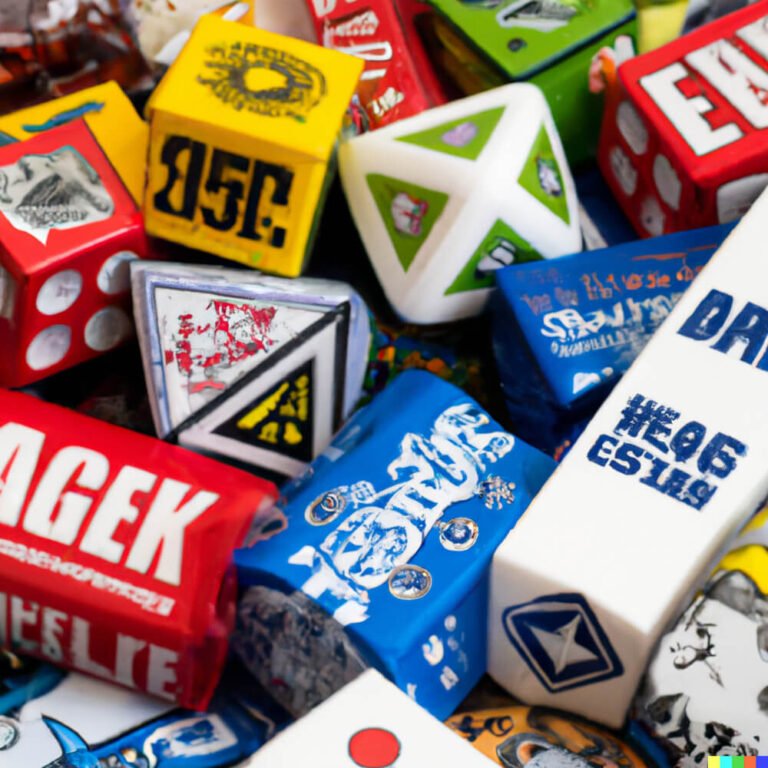Welcome to the thrilling world of Classic Board Game Clue, where suspense, strategy, and deduction reign supreme. Whether you’re a seasoned game enthusiast or just dipping your toes into the world of board games, Clue is a timeless classic that has captured the imaginations of players for generations.
Also known as “Cluedo” in some parts of the world, this iconic board game transports players into a realm of mystery and intrigue. The objective? To solve a perplexing murder case by uncovering the culprit, location, and weapon used. With each player taking on the role of a suspect, it’s a battle of wits to outmaneuver your opponents and piece together the clues.
Since its creation in 1949 by Anthony E. Pratt, Clue has become much more than just a game. It has transformed into a cultural phenomenon that has left an indelible mark on popular culture. From adaptations in movies and books to countless spin-offs and variations, Clue’s influence spans far beyond the confines of the tabletop.
In this article series, we’ll delve deep into the world of Classic Board Game Clue. We’ll explore its rich history, break down exactly how to play step-by-step, introduce you to its memorable characters and locations, showcase its arsenal of weapons, provide tips and strategies to crack the case, examine its various spin-offs and adaptations, and discuss its impact on popular culture.
So grab your detective hat and sharpen your deductive skills because it’s time to embark on an exciting journey through the mysterious mansion that is Clue – where every clue counts and every move could be a game-changer. Let’s unravel this enigmatic puzzle together.
History of Clue
The history of Clue traces back to the early twentieth century when it first originated as a board game in the United Kingdom. However, its origins can be found even earlier in the realm of detective fiction. The concept of Clue was inspired by the popular detective stories and novels that captivated readers during that time.
The game was originally created by Anthony E. Pratt, an English musician and inventor, during World War II. It was initially called “Murder.” and had a simple design with a basic premise: players had to determine who committed a murder by identifying the suspect, weapon, and location of the crime. The game remained unpublished for several years until it caught the attention of major game manufacturer Waddingtons.
In 1949, Waddingtons acquired the rights to “Murder.” and decided to rebrand it as “Cluedo” for its release in Great Britain. The name “Cluedo” was derived from a combination of two words: “clue” (meaning hint or evidence) and “ludo” (the Latin word for I play). Upon its successful launch, Parker Brothers, an American game manufacturer, purchased the rights to publish and distribute Clue in North America.
Over time, Clue’s popularity grew exponentially as it became an icon in board gaming history. It has undergone various modifications and improvements throughout its existence but has retained its essence as a challenging deduction game. Due to its clever blend of strategy, mystery, and suspense, Clue continues to captivate players of all ages today.
As technology advanced, Clue also made its way into digital platforms such as video games and mobile applications. Its enduring appeal is testament to the timeless allure of solving mysteries, making accurate deductions, and immersing oneself in intricate detective work – all within the confines of a beloved classic board game.
How to Play Clue
Clue is a classic board game that has captivated players of all ages for decades. Known for its suspenseful gameplay and mysterious storyline, Clue provides hours of entertainment for those who are up for the challenge. If you’re new to Clue or simply want to brush up on your skills, this step-by-step guide will help you master the game in no time.
The Objective
The objective of Clue is to solve the mystery of who murdered Mr. Boddy, where the murder took place, and which weapon was used. Players take on the roles of different characters, each with their own unique abilities and motives. By collecting clues and making deductive reasoning, players need to correctly guess the three main aspects of the murder before anyone else.
Setting Up
To set up the game, first lay out the game board which depicts different rooms in a mansion. Then, randomly select one character card, room card, and weapon card without revealing them to other players. These three cards represent the solution to the crime and must be placed inside an envelope without anyone seeing.
Next, shuffle the remaining cards and deal them face-down to each player equally until all cards have been distributed. Players will use these cards throughout the game to gather information about potential suspects, weapons, and rooms.
Gameplay
The game proceeds in turns with players moving from room to room through secret passages or by rolling dice on outer paths on the board. When a player enters a room, they can make suggestions about who they think committed the crime by naming a suspect, a weapon, and a room. The player on their left must then try to refute their suggestion by showing them one card from their hand that matches either the suspect or weapon mentioned.
Players can take notes during gameplay to keep track of information they have gathered or eliminate possibilities from their list of suspects, weapons, and rooms. As the game progresses, players will start to narrow down their options and make educated guesses on the solution.
Mastering Clue requires a combination of deduction, strategy, and luck. By paying attention to other players’ suggestions and making calculated moves, you can increase your chances of solving the mystery before anyone else.
With this step-by-step guide, you now have a solid foundation for playing Clue. Remember to think like a detective, trust your instincts, and use your deductive reasoning skills to crack the case. Happy sleuthing.
Character Profiles
Miss Scarlet: The Seductive Femme Fatale
One of the most iconic characters in the game Clue is Miss Scarlet. With her striking red dress and captivating personality, Miss Scarlet is portrayed as a seductive femme fatale. Known for her charm and quick wit, she can often manipulate others to get what she wants. However, her mysterious nature and association with scandalous affairs make her a prime suspect in solving the murder mystery.
Colonel Mustard: The Distinguished Military Man
Colonel Mustard is another prominent character in Clue. As a retired military officer, he brings an air of authority and discipline to the game. With his distinguished mustache and military regalia, Colonel Mustard embodies strength and intelligence. While he may seem trustworthy at first glance, his strategic mind and potential access to various weapons propel him into the realm of suspicion.
Professor Plum: The Brilliant Academic
In the world of Clue, Professor Plum stands out as a brilliant academic with an impressive array of knowledge. His glasses, bowtie, and bookish appearance reflect his intellectual prowess. Often seen lost in thought or engrossed in a scholarly discussion, Professor Plum may come off as absent-minded or eccentric at times. However, his vast understanding of different subjects gives him an edge when it comes to solving the murder mystery.
These are just three examples of the memorable suspects that players encounter in Clue. Each character has their own unique personality traits and motives that add depth and intrigue to the game. As players delve into the world of Clue, they must carefully consider each suspect’s actions and alibis to uncover the truth behind the murder.
So next time you play Clue, take a moment to get acquainted with these fascinating characters. You never know – one of them could be hiding a dark secret or holding a clue to solving the mystery.
Room Descriptions
In the classic board game Clue, players are transported to a mysterious mansion where a murder has taken place. The mansion is filled with various rooms that hold clues to help solve the crime. In this section, we will take a closer look at the different rooms in Clue and their significance in unraveling the mystery.
One of the main objectives in Clue is to determine three key aspects of the crime: who committed the murder, which weapon was used, and where it took place. To gather information, players must move their character tokens around the board and enter various rooms. Each room has its own unique layout and features, making them integral to solving the mystery.
The mansion in Clue is divided into nine rooms: the Kitchen, Ballroom, Conservatory, Dining Room, Billiard Room, Library, Study, Hall, and Lounge. Each room represents a different area of the mansion and holds valuable clues that can help players eliminate suspects and weapons from their list. For example, finding an item or evidence card related to a certain suspect or weapon in a specific room can provide crucial information about their involvement in the crime.
| Room | Description |
|---|---|
| Kitchen | The heart of any home, this room is where delicious meals are prepared. It contains various utensils and tools that could potentially be used as weapons. |
| Library | A quiet sanctuary filled with books and knowledge. The library may hold hidden secrets within its shelves. |
| Lounge | A cozy room where residents can relax and socialize. It may hold conversations or pieces of evidence that shed light on the crime. |
Exploring each room is an essential part of playing Clue, as it allows players to gather information, make deductions, and narrow down the possibilities. By paying attention to the room descriptions and utilizing strategic moves, players can increase their chances of solving the mystery and winning the game.
Weapons Showcase
In the exciting world of the classic board game Clue, one of the most intriguing aspects is the arsenal of deadly weapons that players can use to commit murders and solve mysteries. With a total of six weapons to choose from, each with its own unique characteristics and potential for causing harm, players must carefully consider which weapon they believe was used in the crime.
First on our list is the iconic lead pipe, a heavy and sturdy weapon that can strike silently and without leaving much evidence behind. Its long length provides ample leverage for a powerful swing, making it a favorite among those who prefer a more direct approach when carrying out their dastardly deeds.
Next up is the devious dagger, a small yet deadly weapon known for its precision and ease of concealment. The sharp blade allows for quick and efficient strikes, making it an ideal choice for those seeking a discreet method to dispatch their victims.
The revolver, another popular weapon in Clue’s arsenal, combines elegance with lethality. As one of the most versatile options available, it offers both short-range accuracy and long-range potential. However, players must be cautious as using this weapon may leave behind undeniable evidence in the form of bullet casings.
In addition to these three mainstay weapons, Clue also features three more unconventional choices: the wrench, candlestick, and rope. The wrench may not be as elegant as some other options but it delivers a forceful blow capable of incapacitating even the strongest opponents.
The candlestick’s ornate design adds an air of mystery to any crime scene while still serving as a viable murder weapon. Lastly, we have the rope, which offers both strangulation possibilities and creative opportunities for setting traps or staging accidental deaths.
These six distinctive weapons bring an added layer of suspense and strategic thinking to every game of Clue. Whether you prefer brute force or cunning tactics, the choice of weapon can greatly impact your chances of outsmarting your opponents and solving the mystery. So select your weapon wisely, and may the best detective win.
Tips and Strategies
Clue is not just a game of luck but also requires strategy and deduction skills to solve the mystery. Here are some proven tactics to crack the Clue case and increase your chances of winning:
1. Start with elimination: As soon as you start playing, make notes of the cards that are shown to you by other players or that you discover in your own hand. By process of elimination, you can narrow down the possibilities and determine which cards are not part of the solution. This will help you focus on the remaining cards and narrow down your suspicion.
2. Use the process of elimination: One effective way to narrow down the suspects, rooms, and weapons is by marking off the things that have been disproven throughout the game. For example, if someone shows you a card that matches one of your suspicions, you can mark off that suspect, room, or weapon from your list.
3. Pay attention to player behavior: Observing how other players make suggestions and react to yours can provide valuable clues about their hands and what they may be trying to conceal. If a player repeatedly suggests a certain room or weapon but never shows any cards related to it when others disprove their suggestion, it could mean that they hold one of those cards in their hand.
4. Utilize secret passages: The secret passages on the Clue board can be great strategic tools for moving quickly between rooms. Taking advantage of these shortcuts can allow you to cover more ground in less time and gather more information about what might be happening in different areas of the mansion.
5. Be unpredictable with suggestions: To throw off your opponents’ deductions and make it harder for them to solve the mystery, try making suggestions that do not align with your actual suspicion. By intentionally suggesting suspects, rooms, or weapons that are already known by other players to be innocent, you create confusion and increase the chances that they will waste turns investigating false leads.
By implementing these tips and strategies, you will enhance your detective skills and have a better chance of cracking the Clue case. Remember, the key to success in this classic board game is careful observation, logical deduction, and a bit of luck. Good luck on your journey to become the ultimate Clue master.
Variations and Spin-Offs
The original version of Clue has garnered such popularity and success that it has led to various variations and spin-offs of the game. These alternate versions provide a fresh twist on the classic gameplay, offering players new challenges and experiences. Whether you’re a fan of the original or looking for something different, these variations and spin-offs are sure to keep you entertained.
One popular variation is The Simpsons Clue, which combines the beloved characters from the long-running animated series with the classic Clue gameplay. In this version, players must solve the mystery of who killed Mr. Burns by using familiar locations from Springfield as the rooms and Simpson family members as suspects. It’s a fun and light-hearted take on the game that fans of both Clue and The Simpsons can enjoy.
Another notable spin-off is Clue: Harry Potter Edition, which brings the wizarding world to life in a thrilling murder mystery. Players navigate through Hogwarts School of Witchcraft and Wizardry, seeking clues to uncover who cast an illegal curse on another student. With iconic Harry Potter characters as suspects and enchanted locations as rooms, this version offers a magical twist on the classic gameplay.
For those who prefer a more cooperative experience, there is Clue: Master Detective. This advanced version features additional suspects, weapons, and rooms compared to the original game. Players work together, sharing information and deducing clues collectively in order to solve the complex crime at hand. It’s a challenging twist that requires teamwork and collaboration.
In addition to these variations, there are also themed editions based on popular movies such as Game of Thrones or Star Wars, as well as digital adaptations for smartphones and tablets. With so many options available, it’s easy for enthusiasts to find their preferred version of Clue or try out something new.
Whether you’re playing with friends or family members, these variations and spin-offs provide endless possibilities for murder mystery fun. From beloved TV shows to iconic book series or collaborative gameplay, there’s a Clue game out there for everyone to enjoy. So gather your detectives and start solving mysteries in the world of Clue beyond the original game.
Clue in Popular Culture
The impact of Clue as a classic board game cannot be understated. Its engaging gameplay and intriguing mystery have made it a popular choice for entertainment not only at the table, but also in various forms of media. Over the years, Clue has infiltrated popular culture and influenced movies, books, and more.
Directed by Jonathan Lynn, the movie featured an all-star cast and added a humorous twist to the murder mystery plot. Despite receiving mixed reviews upon release, “Clue” has garnered a cult following and is now considered a beloved classic among fans of both the board game and comedy films.
In addition to movies, Clue has also made its presence felt in literature. Many authors have been inspired by the suspenseful nature of the game and have incorporated elements of Clue into their own works. From murder mysteries set in grand mansions to intricate whodunit novels with multiple suspects, Clue continues to be a source of inspiration for writers around the world.
Beyond movies and books, Clue has also entered other areas of popular culture. The game has been adapted into various forms such as video games, television shows, and even a musical. Its enduring popularity speaks volumes about its cultural significance and timeless appeal.
In conclusion, Clue’s influence on movies, books, and other forms of popular culture cannot be overlooked. From its memorable movie adaptation to its widespread impact on literature and beyond, Clue continues to captivate audiences across different mediums. With its engaging gameplay and thrilling mystery at its core, it’s no wonder that this classic board game remains an enduring favorite that transcends generations.
Frequently Asked Questions
What Is the Original Clue Board Game?
The original Clue board game, also known as Cluedo in some countries, is a classic murder mystery game that was first published in 1949. It was created by Anthony E. Pratt, a clerk from Birmingham, England.
In the game, players take on the roles of suspects trying to solve a murder mystery by deducing who committed the crime, what weapon was used, and where it took place.
How Do You Play the Classic Clue Board Game?
Playing the classic Clue board game involves gathering two to six players who choose a character to play as and receive special cards with their assigned character’s information. The game board represents a mansion with various rooms interconnected by passages and secret passages. One player starts by rolling the dice and moving their token through the mansion.
Each turn allows players to make suggestions about the murder suspect’s identity, weapon used, or location. Other players must reveal any cards they have related to the suggestion made. The game continues until one player successfully solves the mystery by making an accusation that matches all three aspects of the crime.
What Is the American Board Game Clue?
The American board game version of Clue is essentially the same as its British counterpart but with minor changes in character names and other details. For example, Mr. Boddy is called Dr. Black in the American version, and Miss Scarlet’s background story differs slightly between versions as well.
These changes were made when Parker Brothers introduced Clue for distribution in the United States in 1949 after adapting it from its original British release in 1948 as “Cluedo.” Overall, though there may be slight differences between them, the American Clue board game retains much of the charm and gameplay mechanics of its British predecessor.

I love playing all kinds of games – from classics like Monopoly to modern favourites like Ticket to Ride.
I created this blog as a way to share my love of board games with others, and provide information on the latest releases and news in the industry.





